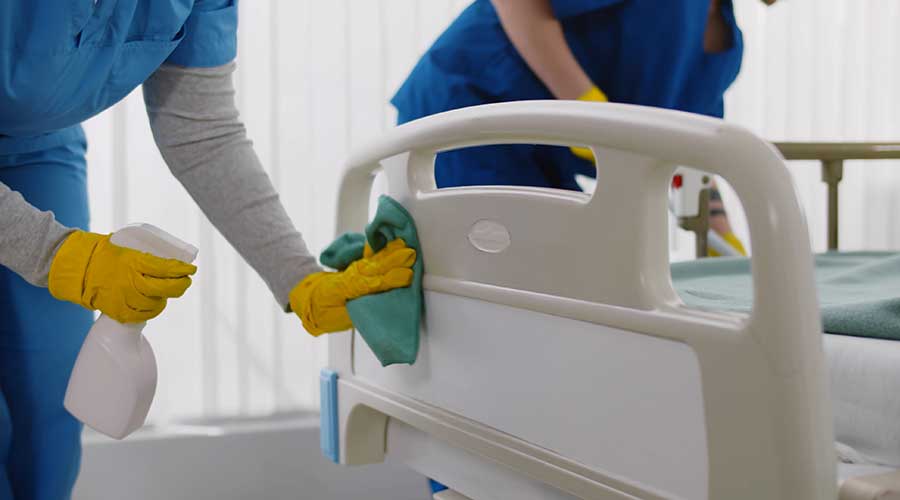It has long been understood that contaminated housekeeping surfaces and patient-care equipment are a major source of healthcare-associated infections (HAI). Even after routine disinfection, clinically relevant organisms such as MRSA, VRE and C-diff can persist in healthcare environments and be transmitted to other patients.
The U.S. Environmental Protection Agency (EPA) does not require clinical evidence of efficacy for registration of disinfectants, which is in stark contrast to the U.S. Food and Drug Administration (FDA), which requires evidence of clinical efficacy to approve antimicrobial products. This difference is problematic because public health claims allowed by the EPA are based on in vitro — studies and tests on organic matter in a controlled laboratory setting — assays and not in the real world.
It is time for a reality check when it comes to disinfecting environmental surfaces. A huge gap remains between government registration protocols for disinfectants and processing an emergency department trauma room after a gunshot victim has received life-saving medical treatment. The disinfectant the environmental services technician (EST) uses to clean up blood, bone and human tissue was purchased with input from the infection prevention department. Unfortunately, many such disinfectants are either ineffective for the purpose or used improperly. Why?
First, the registration process for healthcare-grade disinfectants is based on flawed methods for microbicidal activity. While materials managers and infection preventionists purchase and use only government-registered products, the registration process for environmental surface disinfectants is often based on flawed methods for microbial activity.
Second, consider the spectrum of microbial activity. Frequently, a chemical disinfectant is tested against gram-positive and gram-negative bacteria only, but the label claims “broad spectrum activity.”
“The use of this antibiotic-relevant term is totally inappropriate for disinfectants," says Dr. Syed A Sattar. “The correct use of the term must be given a disinfectant’s ability to inactivate not only vegetative bacteria but viruses and fungi as well, which are common nosocomial pathogens. Therefore, the registration number on the product label itself is of limited value.”
Third, disinfectants are tested without any wiping action. Even though most surfaces are disinfected with wiping, testing and label claims of products used for the purpose rarely entail any wiping, which is a serious omission.
When the environmental services tech (EST) is processing the aftermath in the trauma room, the gurney is not submerged in disinfectant for 10 minutes as the label states for contact time, although that is the how the product testing is performed. In the real world, an EST employs a microfiber wiper, a disinfectant and elbow grease to process surfaces and equipment according to hospital protocols. The mechanical action of wiping contributes significantly to soil removal and rendering surfaces “safe, clean and disinfected”.
Applying evidence-based food-industry cleaning standards modified for hospital settings could aid in the development of better antimicrobial efficacy tests to provide a benchmark of necessary microbial action.
Ultimately, a better understanding of the role of the environment in the transmission of HAIs, the role of specific reservoirs and ways to optimally reduce these reservoirs will lead to more effective use of disinfectants in healthcare settings that can translate into a much-needed reduction in HAIs.
J. Darrel Hicks, BA, MESRE, CHESP, Certificate of Mastery in Infection Prevention is the Past President of the Healthcare Surfaces Institute. Hicks is nationally recognized as a subject matter expert in infection prevention and control as it relates to cleaning. He is the owner/principal of Safe, Clean and Disinfected. His enterprise specializes in B2B consulting, webinar presentations, seminars and facility consulting services related to cleaning and disinfection. Learn more at www.darrelhicks.com.

 UF Health Hospitals Rely on Green Globes to Realize Their Full Potential
UF Health Hospitals Rely on Green Globes to Realize Their Full Potential How Healthcare Facilities Can Be Truly Disaster-Resilient
How Healthcare Facilities Can Be Truly Disaster-Resilient TriasMD Breaks Ground on DISC Surgery Center for San Fernando Valley
TriasMD Breaks Ground on DISC Surgery Center for San Fernando Valley Bigfork Valley Hospital Falls Victim to Data Breach
Bigfork Valley Hospital Falls Victim to Data Breach AI-Driven Facilities: Strategic Planning and Cost Management
AI-Driven Facilities: Strategic Planning and Cost Management